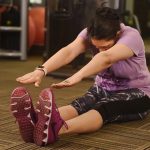What is Power Walking?
Power walking is walking at a faster pace than what is considered natural. This typically means that your pace is around 4 to 5.5 mph, or a 15 to 13 minute mile. You must have at least one foot on the ground at all times when power walking.
A 126lb person (9 stone) burns approximately 120 calories in 30-minutes, walking at 3.5 mph. If they walk at 4.5 mph, they will burn approximately 180 calories. A marathon is about 1,796 or 2,096 calories.
Want to find out how many calories you would burn walking? Use Health Surgeon’s calories burned calculator to discover how many calories you can burn doing over 100 different activities.
How to Power Walk
If you have just started power walking, you should be aware of your posture and form. To get the most out of your walking workout, you should walk briskly. Here is what you need to know about getting started with power walking.
Maintain Good Posture and Use Your Arms
Many people have poor posture because they stick their head out when they walk. Keep your back straight and stand up tall. You should also keep your chin level and relax your shoulders.
Swinging your arms faster will help you burn more calories and work your upper body more. Swing your arms back and forth vigorously with each step, keeping your elbows bent at a 90-degree angle.
Use a Good Stride
The American College of Sports Medicine says you should make contact with your heels while keeping your feet pointing ahead. Start by pushing off with your toes, and then keep a consistent pace by rolling your feet from heel to toe.
When running, you want to make sure your strides are shorter. One of the biggest mistakes people make when running is to overstride, thinking that it will help them go faster. But it is actually the opposite. If you want to go faster, you should take shorter, quicker steps.
Additionally, research indicates that taking more steps per minute can provide a number of health benefits. For example, it can help you control your insulin levels and also help you lose weight.
As you prepare for power walking, you should also invest in a good pair of walking shoes. The shoes you wear while working out should be flexible to allow you to move easily, supportive to help your feet stay comfortable, and lightweight to help you move quickly.
Make It a Workout
Whilst you do not need to be out of breath when you power walk, you should breathe to the point where you have a little bit of difficulty talking. You should slow down if you cannot speak at all– especially if you are a beginner.
You should walk briskly and for a long enough time to get the most out of your workout.
If you want to get a workout and raise your heart rate, try walking quickly while also engaging your arms and your core. This has a number of health benefits.
You can use a pace calculator to figure out how fast you’re walking if you’re not sure. The following information will help you to determine whether you need to walk faster in order to experience the health benefits of power walking.
Power Walking Techniques and Tips
It’s All in the Technique
You can become a power walker by making some simple changes to your technique.
Stand tall with your feet together, relaxed shoulders, pulled-in abdominals, and your bottom tucked under. Your pelvis should be slightly forward and square to the direction you’re walking.
Stand with your arms at your sides and your hands cupped softly. You’re ready to start.
There are some things you should avoid doing while walking if you want to maintain a good pace and prevent injuries. Here are some tips on what NOT to do.
- Don’t let your arms dangle by your sides… always keep them at 90° to your side and really pump them backwards and forwards as you walk… give it a try and watch your feet pick up the pace.
- Don’t lean forward as you walk… you won’t get there any faster and worse still, this position can give you lower back pain… think about holding good posture at all times.
- Don’t over stride… you might feel you are going to speed up but actually, it’s the opposite, to go faster you need to take smaller steps.
Shoes and Kit for Safe Walking
Before you purchase new shoes, consult our information page to make sure you know what features to look for. The best trail shoes will be waterproof and comfortable, so make sure to check both of those boxes before making your purchase.
If you want your shoes to last, it is estimated that you should replace them after 500 miles of wear.
The support on your shoes can wear down after a certain amount of mileage, causing problems for your feet. Make sure that your shoes are suitable for the training and the challenge itself!
What to Wear for Cold and Wet Walking
‘There’s no such thing as bad weather, just the wrong clothes’… so don’t let the bad weather keep you from getting out and doing a few miles, all you need is the right clothing and you can feel warm, dry and comfortable.
- Lightweight waterproof and breathable jacket
- Leggings or high wicking jog pants
- Wicking T-shirt or training top
- Waterproof Gortex or similar shoes
- Pull on Beanie
- Neck buff to keep out the cold and rain drips
- Gloves
- Bumbag and water bottle holder – always carry water even on short walks
- Hi-Viz items to make sure you are seen – make sure you tell someone your planned route and when you will be due back and take a fully charged mobile with you (just to be safe).
Health Benefits of Power Walking
Walking is often recommended by health professionals because it has many benefits for your overall health. For example, walking can improve muscle tone, help with weight management, and boost cardiovascular health.
You can increase the benefits of walking by power walking.
The benefits of power walking:
- Burns more calories than regular walking
- Tones the muscles in the legs and buttocks
- Improves cardiovascular fitness
- Reduces stress
- Lowers blood pressure
Low-impact, low risk of injury and walking can help develop and keep bones strong.
Walking is an excellent form of exercise for the whole body.
The more you walk, the better your muscle tone and strength will become.
Walking gives you a boost.
The evidence that physical activity reduces the risk of breast cancer is strong. Walking is a good way to get physical activity. You can easily boost your immune system by walking every day.
Improves your general health.
Walking quickly can help improve cholesterol levels and lower blood pressure, which reduces the risk of diseases like type 2 diabetes, some types of cancer, and strokes.
Relieves stress.
Regular Power Walking can help take your mind off of stressful environments and situations, and help you to relax.
Exercise can help improve your mood by releasing endorphins in your brain. Endorphins are hormones that give you a more relaxed disposition and can help reduce symptoms associated with depression, anxiety and low self-esteem.
You should try to take a 15 minute walk every day during your lunchtime. Turn off your phone and just enjoy where you are walking.
If you take a break from your normal routine, you’ll feel a great sense of freedom. You’ll probably want to extend that break once you experience how good it feels to relax and just be in the moment.
Walking off the weight.
While quitting smoking is the most important thing you can do to prevent cancer, keeping a healthy weight is the next best thing. A healthier diet combined with walking is an effective way to lose weight, get good muscle tone, and maintain it.
If you walk for 45 minutes 4 times a week at a pace that gets your heart rate up, tests have shown that you could lose up to 18 pounds without changing your diet.
There are several studies that show how walking can help you reach your weight loss goals.
A study looking at 3,388 people found that those who walk with a quicker pace tend to have a smaller waist circumference, for both men and women.
Reducing the pace of walking helped study participants reduce their body mass index, weight, and insulin levels. The study found that men typically took between 2,247 and 12,334 steps per day, while women typically took between 1,755 and 9,824 steps per day.
The study found that walking quickly can help with weight management goals, even though the speeds in the study were faster than normal walking speeds, but not as fast as power walking.
Walk away PMS.
Regular walking will minimize bloating and reduce fluid retention. Because endorphins are released when your heart rate increases, you’ll have a better outlook on life and be able to handle stress better.
Reduce menopause symptoms.
Women who walk at a pace that increases their heart rate 3-4 times a week reported fewer hot flushes and said it improved their quality of life by helping them in both body and mind.
Power walking is cheap.
It doesn’t require any expensive equipment, it’s accessible to everyone and doesn’t require a gym membership… just take a step outside!
Make it social.
Reach your walking goals with your friends and family and have a great time doing it.
Data was reviewed on over 1800 walker in 14 countries. Researchers found that participants in walking groups improved lung power, had greater overall fitness and were less depressed after joining a walking group.
Improves Fitness Level
Power walking has a greater fitness impact than traditional walking. This means that if you want to get in better shape, you should walk quickly for six weeks.
The researchers found that the power walking group had greater improvements in heart function and blood pressure than the usual walking group. The researchers divided the patients into two groups, a power walking group and a usual walking group, in a study on patients in a phase 2 cardiac rehabilitation program and found that the power walking group had greater improvements in heart function and blood pressure than the usual walking group.
Everyone in the study took graded exercise tests and had their maximal oxygen consumption measured while they were on an aerobic treadmill exercise.
The exercises and measurements lasted for 50 minutes and were conducted three times a week throughout a six-week period. The results showed that people who power walk have a higher oxygen intake than people who walk normally.
The importance of this type of measurement is especially relevant in rehabilitation programs, as it is often considered the best way to gauge cardiovascular fitness and aerobic endurance. If you’re looking to improve your fitness and endurance, give power walking a try.
Boosts Cardiovascular Health
The recent research shows that power walking can help to improve heart health, especially for those who have had a heart event.
In a clinical trial with 24 patients, some were assigned to a group where they power-walked on a treadmill as part of a standardized outpatient cardiac rehabilitation program. The others were in a control group where they didn’t do this.
For four weeks, researchers had study participants take a six-minute walk test and answer a questionnaire.
The research team also looked at other factors that could affect heart health, including exercise stress, the number of steps taken each day, and heart rates. They did this by using an echocardiogram. The results of the study showed that the people who power walked as part of their cardiac rehabilitation program showed significant improvement.
Conclusion
Power walking is an exercise easily amenable to anyone. Although some people dread working out, power walking may be enjoyable for them because it is gentle on the joints and relatively inexpensive.
There are a few things you can do to make power walking more effective, like rolling your foot from heel to toe, bending your arms, and keeping good posture. As long as you do these things consistently, you can help improve your heart health and burn calories.
Before starting to work out regularly, it is important to speak to a healthcare provider. They can advise you based on your medical history and fitness level.









